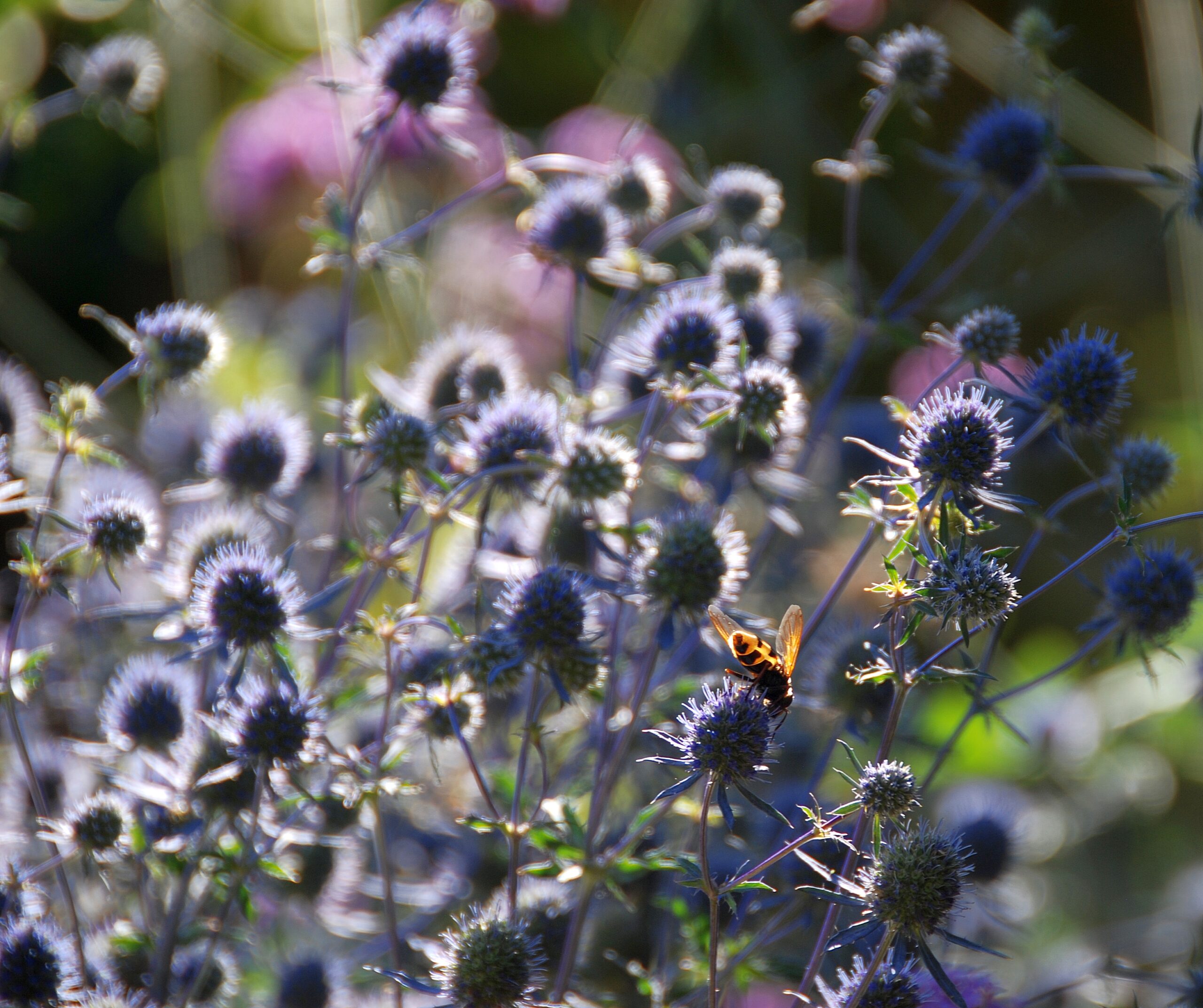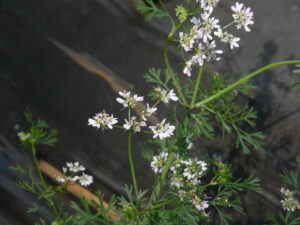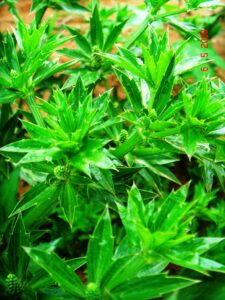Culantro
Overview
Culantro is a vibrant, tropical perennial herb with a deep green hue and a tantalizing aroma that enlivens a variety of dishes. Under the scientific name Eryngium foetidum, and part of the Apiaceae family, it flourishes in partial shade with moist, fertile soil. While its spiky blossoms are a sight to behold, culantro is cherished most before it seeds, when its leaves deliver their fullest flavor.

Characteristics
Known for its strong aroma, spiky green blossoms, and culinary significance in tropical regions.
Region
The Culantro plant is usually found or grown in tropical regions in Central and South America, Southeast Asia, and the Caribbean.
Natural Habitat
Culantro is usually found in the wild in moist, shaded areas such as forests and swamps.
Cultivation
Prefers partial shade, regular watering to maintain moist soil, and fertile, well-drained soil with pH 6.0-7.5.
Uses and Benefits
Culantro’s benefits are far-reaching, making it a valuable addition to any home garden. Its leaves are packed with essential nutrients like vitamins A, B, and C, as well as calcium and iron, providing a healthful boost to your meals.
But culantro’s perks don’t stop there. This herb has been used in traditional remedies for its potential medicinal properties:
- May aid digestion
- Could serve as a natural pain reliever
- Might offer anti-inflammatory benefits1
As a bonus, culantro can even help keep pesky mosquitoes at bay, making it a practical choice for your outdoor space.
Gardeners also appreciate culantro for its ease of care and love of shady spots. It thrives in the shade, making it an ideal companion for other shade-loving herbs in your garden sanctuary.

Cultivation Tips
For those eager to enjoy the unique taste of culantro (Eryngium foetidum) fresh from their own herb garden, starting plants indoors is a smart strategy. Find a spot that maintains a consistent, warm temperature to promote successful germination, and keep the soil moist but not soggy. If you have access to a mature culantro plant, propagating from cuttings can also be effective. Choose cuttings with healthy leaves and a good root system for the best results1.
When your seedlings or cuttings are ready to brave the great outdoors, select a garden location that mirrors culantro’s native tropical environment:
- Partial shade is ideal, as culantro thrives in dappled light
- Well-draining soil with a pH between 6.0 and 7.5 is crucial
- Enrich the planting area with aged compost or other organic matter to promote healthy growth2 3 4
While culantro is tolerant of moisture, it’s important to avoid oversaturating the soil, as this can lead to root rot and other issues. Aim for consistently moist ground without allowing it to become waterlogged3.
To keep your culantro plants productive and flavorful, be proactive about removing flower stalks as they appear. This practice, known as pinching or deadheading, serves two purposes:
- It keeps the leaves tender and tasty for your culinary creations
- It encourages the plant to focus its energy on producing lush, abundant foliage3
By following these cultivation tips, you’ll be well on your way to enjoying a bountiful harvest of aromatic, flavorful culantro right from your own herb garden.
Seasonal Considerations
For the herb gardener looking to add the unique flavor of Culantro (Eryngium foetidum) to their plot, starting seeds indoors is often the most reliable approach. Find a consistently warm location to encourage good germination rates, and keep the soil evenly moist as the seedlings develop. If you’re lucky enough to have a mature culantro plant already, taking cuttings can be an effective way to propagate new plants. Just make sure each cutting has a healthy set of leaves and roots to give it the best chance of thriving1.
When your seedlings or cuttings are ready to brave the great outdoors, keep in mind that culantro prefers shady conditions. Aim to replicate its natural tropical habitat by selecting a spot with partial shade and fertile, well-draining soil. While culantro can handle moist conditions, avoid overly soggy soil that can lead to root rot. The ideal soil pH falls between 6.0-7.5. Give your plants a great start by working aged compost or other organic matter into the soil before planting2 3 4.
As your culantro grows, keep a watchful eye out for flower stalks. Pinching these off as they appear serves two important purposes:
- It keeps the leaves tender and full of flavor for your cooking.
- Removing the flowers encourages the plant to put more energy into lush foliage growth, ultimately extending your harvest window and the time you get to enjoy this distinctive herb3.
With the right attention to shade, soil, and strategic pruning, you’ll be well on your way to successfully integrating culantro into your herb garden and culinary adventures.

Issues and Troubleshooting
Culantro’s primary challenge is its propensity to bolt, particularly when exposed to excessive sunlight. Bolting occurs when the plant shifts its focus to seed production, resulting in sparse foliage and diminished flavor of the coveted leaves4. To mitigate this issue:
- Ensure your culantro is situated in a cool, shaded location to prevent premature bolting.
- Regularly pinch or cut off any emerging flowering stalks to redirect the plant’s energy back into leaf growth3.
By carefully managing light exposure and employing timely harvesting practices, you can encourage your culantro plant to produce an abundance of flavorful leaves throughout the growing season. Remember, consistent care and attention to your plant’s needs are key to achieving a bountiful and delicious harvest.
History and Folklore
Culantro, with its rich history and cultural significance, has been a beloved herb in many parts of the world. For centuries, this tropical perennial has been used not just to add flavor to dishes but also for its believed medicinal properties in folk traditions1.
In the Caribbean, culantro holds a special place in both cuisine and spiritual practices. It is often used to cleanse spaces of negative energies, reflecting the belief in its mystical powers. This herb is also a key ingredient in many regional dishes, adding its distinct flavor to the vibrant culinary scene.
Across Central America, culantro’s roots are deeply embedded in folk medicine. Traditional healers have long used this plant to treat various ailments, from fevers to convulsions2. Its therapeutic properties have been passed down through generations, showcasing the enduring wisdom of ancestral knowledge.
The unique aroma and resilient nature of culantro have contributed to its lasting presence in cultural practices. Its ability to thrive in various conditions has made it a reliable ally for communities that rely on its both practical and mystical virtues. As a result, culantro continues to be celebrated and cherished as a vital part of many cultures’ heritage.
References
1. Growing Culantro: Planting, Care, and Harvesting This Tasty Herb, https://morningchores.com/growing-culantro/
2. Growing the Culantro Plant | General Planting & Growing Tips, https://bonnieplants.com/blogs/how-to-grow/growing-culantro
3. Culantro Growing Conditions – Information On Culantro Plant Care …, https://www.gardeningknowhow.com/edible/herbs/culantro/growing-culantro-herbs.htm
4. Culantro – Gardening Solutions – University of Florida, Institute of …, https://gardeningsolutions.ifas.ufl.edu/plants/edibles/vegetables/culantro.html
5. Everything About Growing Culantro | Culantro Herb Care – Balcony Garden Web, https://balconygardenweb.com/everything-about-growing-culantro-herb-care/
Image Credit: antonychammond Attribution-NonCommercial-ShareAlike License
Image Credit: Dinesh Valke Attribution-ShareAlike License
Image Credit: Ahmad Fuad Morad Attribution-NonCommercial-ShareAlike License
Nicolas Duval
Nicolas is a passionate advocate for nature and the art of wildcrafting. His dedication shines through in Wildcraftia, a website he meticulously crafted to serve as a haven for nature enthusiasts worldwide. Driven by a deep appreciation for nature’s connection to humanity, Nicolas embarked on his journey in 2011 with SmokableHerbs, a platform showcasing his love for nature’s bounty. Building upon this foundation, he established Smokably, a thriving online store offering premium herbs and blends to a global audience.
